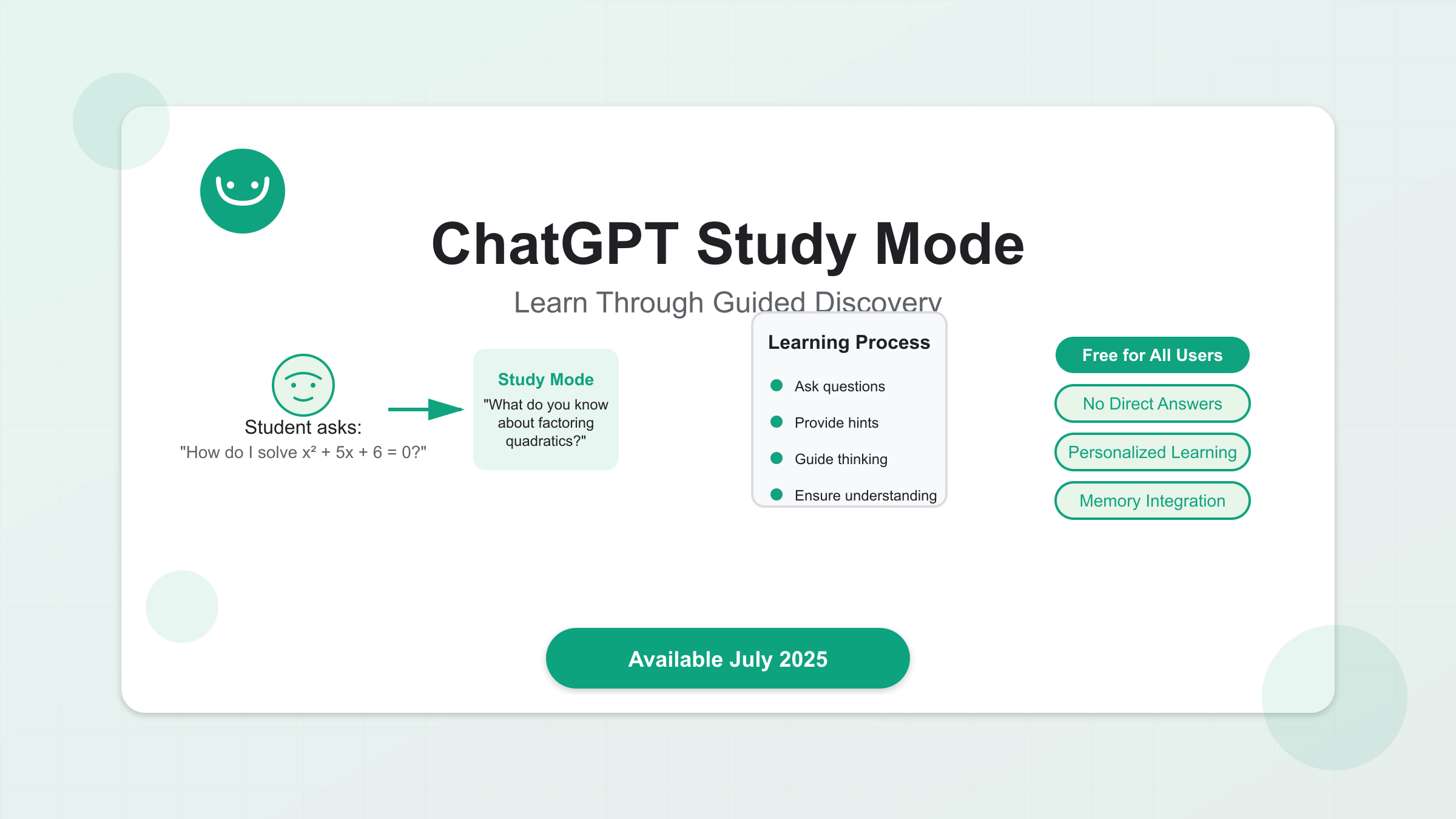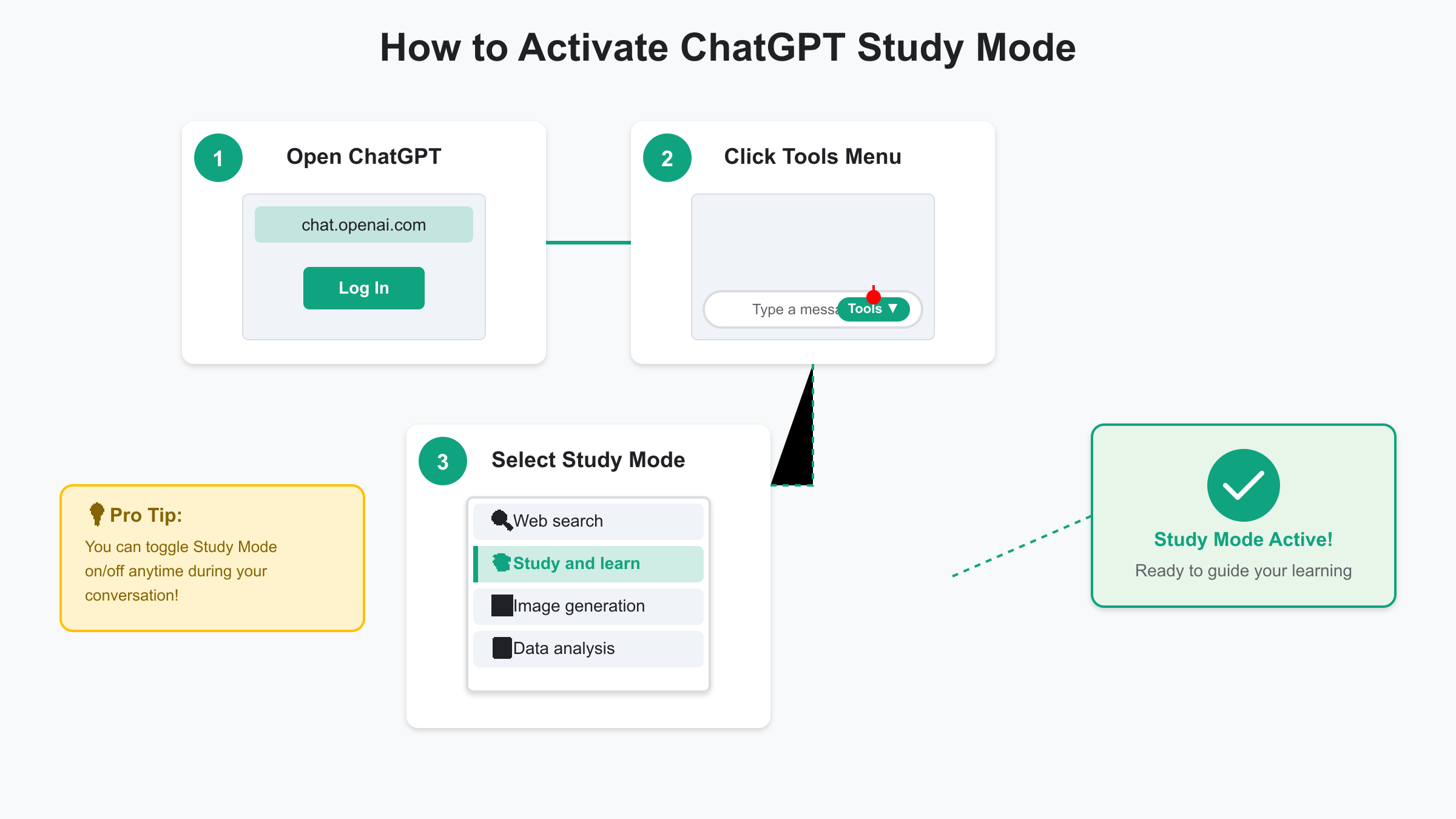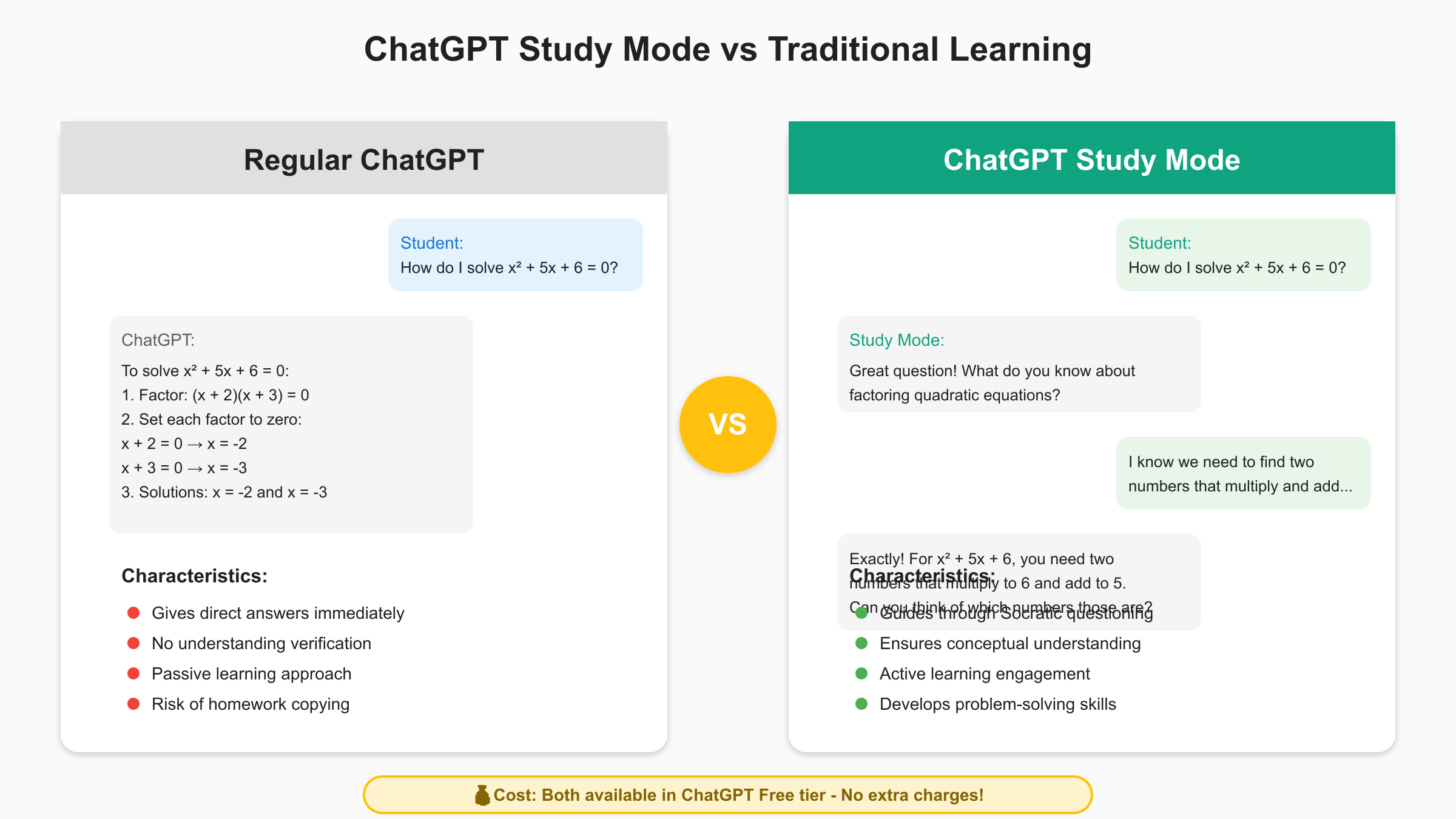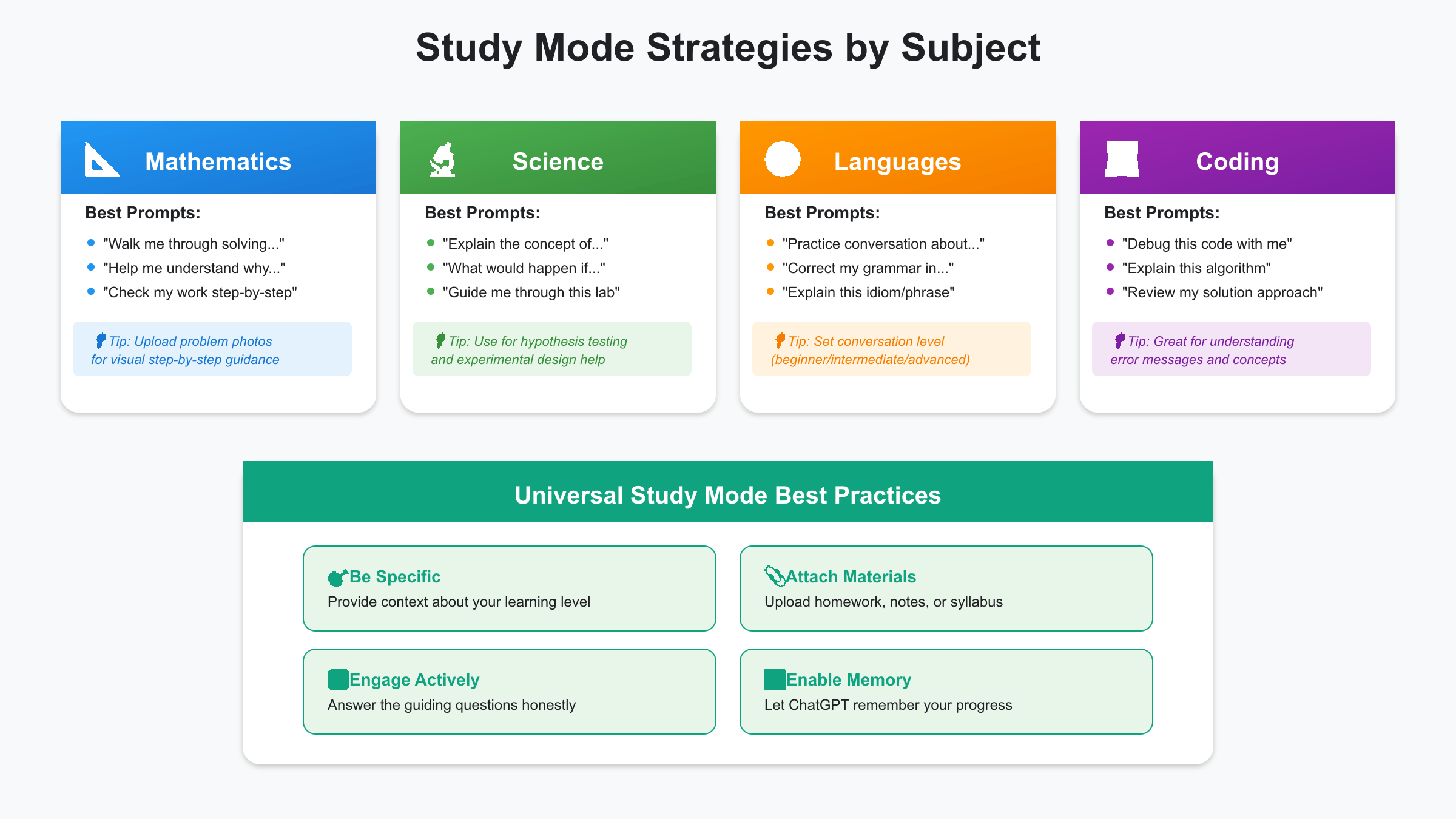ChatGPT Study Mode: Complete Guide to AI-Powered Learning [2025]
ChatGPT Study Mode is a free learning feature that uses Socratic questioning to guide students through problems step-by-step instead of providing direct answers. Launched July 2025, it’s available to all ChatGPT users by selecting ‘Study and learn’ from the Tools menu. Unlike regular ChatGPT, Study Mode asks follow-up questions, provides hints, and ensures understanding before moving forward.

What is ChatGPT Study Mode? Understanding the Basics
ChatGPT Study Mode represents a fundamental shift in how artificial intelligence approaches education. Rather than functioning as an answer machine that provides instant solutions, Study Mode transforms ChatGPT into a patient tutor that guides learners through the discovery process. This innovative feature, introduced by OpenAI on July 29, 2025, implements centuries-old Socratic teaching methods through modern AI technology.
The core philosophy behind Study Mode centers on active learning rather than passive consumption. When students pose questions, instead of receiving immediate answers, they encounter thoughtful counter-questions designed to activate prior knowledge and build new understanding incrementally. This approach mirrors how expert human tutors work, asking “What do you already know about this topic?” or “What would happen if we changed this variable?” to stimulate critical thinking. The method is grounded in Socratic educational philosophy.
Technical implementation relies on custom system instructions developed through collaboration with pedagogy experts from over 40 educational institutions worldwide. These instructions modify ChatGPT’s behavior at the foundational level, ensuring consistent Socratic responses across all academic subjects. The system doesn’t use a different AI model; rather, it applies sophisticated prompting techniques that fundamentally alter the interaction paradigm.
Availability extends across all ChatGPT access tiers, making this powerful learning tool accessible to everyone. Free tier users enjoy the same Study Mode capabilities as paid subscribers, democratizing access to AI-powered tutoring despite ChatGPT’s free tier limitations. The feature works seamlessly on web browsers, mobile apps, and even through third-party integrations, ensuring students can learn anywhere, anytime.
How to Activate ChatGPT Study Mode: Step-by-Step Guide
Activating Study Mode requires just a few clicks, but the process varies slightly depending on your platform. Understanding these nuances ensures smooth activation and prevents common frustrations that new users often encounter.

For web browser users, the process begins by logging into ChatGPT at chat.openai.com. Once logged in, look for the text input field at the bottom of the conversation window. Adjacent to this field, you’ll find a “Tools” button or menu icon. Clicking this reveals a dropdown menu containing various ChatGPT features. Select “Study and learn” from this menu, and you’ll notice the interface subtly changes to indicate Study Mode is active. A book icon or educational indicator typically appears, confirming the mode switch.
Mobile app activation follows a similar pattern but with interface adjustments for touchscreen use. After opening the ChatGPT app on iOS or Android, tap the tools icon (often represented by a grid or menu symbol) near the message input area. The “Study and learn” option appears among other tools like image generation and web browsing. Tapping this option enables Study Mode, with visual confirmation through icon changes or color adjustments in the interface.
Toggling between modes offers flexibility for different learning needs. Students can switch Study Mode on or off mid-conversation without losing context. This proves particularly useful when transitioning from guided learning to quick reference checks. To deactivate Study Mode, simply return to the Tools menu and deselect “Study and learn.” The conversation continues seamlessly, but ChatGPT reverts to providing direct answers rather than Socratic guidance.
Platform-specific considerations affect the activation experience. Browser extensions and third-party ChatGPT interfaces may display the Tools menu differently. Some older mobile app versions might require updates to access Study Mode. Users encountering activation issues should ensure they’re using the latest version of their chosen platform and have logged into their ChatGPT account, as Study Mode isn’t available to anonymous users.
ChatGPT Study Mode Features: What Makes It Different
The feature set of ChatGPT Study Mode extends far beyond simple question modification. Each component works synergistically to create a comprehensive learning environment that adapts to individual student needs while maintaining pedagogical integrity.
Interactive prompting serves as the cornerstone feature, transforming every student question into an opportunity for deeper exploration. Instead of receiving “The answer is X,” students encounter responses like “That’s an interesting problem. What approach have you considered so far?” This prompting style activates metacognition—thinking about thinking—which research shows significantly improves learning retention and problem-solving skills.
Scaffolded learning approaches break complex concepts into manageable steps, respecting cognitive load limitations. When tackling multifaceted problems, Study Mode presents information progressively, ensuring students master foundational concepts before advancing. This scaffolding adjusts dynamically based on student responses, providing more support when confusion appears and stepping back when understanding emerges.
Memory integration elevates personalization to unprecedented levels. When enabled, ChatGPT remembers previous learning sessions, tracking which concepts students have mastered and where they struggle. This persistent memory creates a truly personalized tutoring experience. A student who struggled with quadratic equations last week receives different guidance than one who breezed through the topic, even when asking identical questions.
The no-direct-answers policy might initially frustrate students accustomed to instant gratification, but it serves a crucial pedagogical purpose. By refusing to provide immediate solutions, Study Mode forces active engagement with material. This “desirable difficulty” strengthens neural pathways associated with problem-solving and creates more durable learning than passive information consumption. Students learn not just what the answer is, but why it works and how to find similar solutions independently.
ChatGPT Study Mode vs Regular ChatGPT: Key Differences
Understanding the distinctions between Study Mode and regular ChatGPT helps students choose the appropriate tool for their learning objectives. These differences extend beyond surface-level interactions to fundamental approaches in knowledge construction and skill development.

Regular ChatGPT operates as an information retrieval system optimized for efficiency. When asked about solving quadratic equations, it provides step-by-step solutions, formulas, and examples. This approach works well for quick reference, fact-checking, or when students need immediate answers for time-sensitive tasks. However, research consistently shows that receiving answers without struggling to find them results in shallow learning that quickly fades.
Study Mode fundamentally alters this dynamic by prioritizing understanding over answers. The same quadratic equation query triggers a series of guided questions: “What do you know about the structure of quadratic equations?” followed by “Can you identify the coefficients in your equation?” This Socratic approach requires students to actively construct knowledge, creating deeper neural encoding that enhances long-term retention and transfer to novel problems.
Learning outcomes differ dramatically between modes. Students using regular ChatGPT often complete homework faster but struggle on exams when similar problems appear without AI assistance. Study Mode users report initial frustration with the slower pace but demonstrate superior problem-solving abilities when facing new challenges independently. This aligns with educational research showing that productive struggle during learning correlates with improved performance in testing situations.
Academic integrity considerations favor Study Mode for homework assistance. Educational institutions increasingly recognize the difference between using AI for learning versus using it for answer generation. Study Mode’s approach aligns with academic honesty policies by ensuring students engage with material rather than outsourcing their thinking. Teachers report greater acceptance of Study Mode use compared to regular ChatGPT, as it preserves the learning process while providing support. For broader AI comparison, see our ChatGPT Plus vs Gemini Pro comparison guide.
Best ChatGPT Study Mode Prompts by Subject
Mastering subject-specific prompting strategies dramatically enhances Study Mode effectiveness. Each academic discipline benefits from tailored approaches that align with its unique learning objectives and problem-solving methods.

Mathematics prompting requires precision and step-by-step thinking. Effective prompts include “I’m working on this calculus problem: [problem]. Help me understand what I should consider first” rather than “Solve this for me.” Upload images of handwritten work with prompts like “I’ve attempted this problem. Can you guide me through checking my approach?” This visual element allows Study Mode to identify specific misconceptions and provide targeted guidance. For conceptual understanding, try “I’m learning about derivatives. What foundational concepts should I master before diving deeper?”
Science exploration benefits from hypothesis-driven prompts that mirror the scientific method. Instead of asking “What causes photosynthesis?” try “I’m designing an experiment about photosynthesis. Help me develop a testable hypothesis.” This approach encourages scientific thinking rather than rote memorization. For laboratory work, prompts like “I observed [result] in my experiment. Guide me through analyzing what this might mean” transform Study Mode into a virtual lab partner who helps interpret results without providing conclusions.
Language learning through Study Mode excels with conversational practice prompts. “I want to practice Spanish conversations about traveling. Correct my grammar as we go” creates an interactive language exchange. The system provides corrections through questioning: “You said ‘Yo fue al tienda.’ What tense were you trying to use?” This discovery-based correction proves more effective than simple error highlighting. For vocabulary building, try “I encountered this French idiom: [idiom]. Help me understand its meaning through context.”
Programming and debugging represent ideal use cases for Study Mode’s questioning approach. Prompts like “My Python code produces this error: [error message]. Help me understand what’s happening” trigger systematic debugging guidance. Rather than fixing code directly, Study Mode asks “What do you think this error message is telling you?” and “Where in your code might this issue originate?” For algorithm understanding, try “I need to implement a sorting algorithm. What factors should I consider before choosing one?” This develops algorithmic thinking beyond memorizing implementations.
ChatGPT Study Mode for Different Learning Levels
Adapting Study Mode strategies across educational levels ensures age-appropriate learning experiences. The system’s flexibility accommodates everything from elementary arithmetic to doctoral research, but optimal use requires understanding level-specific approaches.
Elementary school applications focus on building foundational understanding through concrete examples. Young learners benefit from prompts that connect abstract concepts to familiar experiences. “I’m learning multiplication. Can you help me understand why 3 × 4 equals 12 using things I see every day?” triggers responses that might explore arranging toys in groups or counting cookies on baking sheets. The questioning remains gentle and encouraging, building confidence alongside competence.
High school optimization leverages Study Mode’s ability to handle complex, multi-step problems. Advanced placement students preparing for standardized tests find particular value in prompts like “I’m studying for the AP Chemistry exam. Guide me through understanding periodic trends.” The system responds with progressively challenging questions that mirror exam complexity while building deep conceptual understanding. This level benefits from combining Study Mode with other ChatGPT features, such as image analysis for geometry problems or data interpretation for statistics courses.
College and university applications extend into specialized academic territories. Undergraduate students use prompts like “I’m writing a paper on postcolonial literature. Help me develop a thesis through questioning” to refine arguments. Graduate students benefit from methodological guidance: “I’m designing a research study on cognitive bias. What factors should I consider for validity?” Study Mode at this level functions less as a tutor and more as a scholarly colleague who challenges assumptions and suggests new perspectives.
Professional development through Study Mode helps working adults acquire new skills efficiently. Prompts like “I’m learning project management methodologies. How do Agile and Waterfall approaches differ in practice?” generate guided exploration relevant to workplace applications. The system adapts to professional contexts, using industry-appropriate examples and focusing on practical implementation rather than theoretical understanding. This makes Study Mode valuable for career transitions, certification preparation, and continuous professional education.
Maximizing ChatGPT Study Mode with Memory Settings
Memory functionality transforms ChatGPT Study Mode from a helpful tool into a personalized learning companion that evolves with each interaction. Understanding how to leverage this feature optimally creates a compound learning effect where each session builds upon previous knowledge.
Enabling memory requires navigating to ChatGPT settings and toggling the memory feature on. Once activated, Study Mode begins tracking learning patterns, common mistakes, mastered concepts, and individual learning pace. This information persists across sessions, creating continuity typically found only in human tutoring relationships. Students returning after a week find ChatGPT remembers their struggles with specific topics and adjusts questioning accordingly.
Information storage follows privacy-conscious principles while maintaining educational utility. The system remembers conceptual understanding levels rather than specific personal details. For instance, it might store “struggles with integration by parts” or “demonstrates strong grasp of cellular biology” rather than homework answers or test scores. This approach preserves learning insights while respecting student privacy. Users can review stored memories through settings, understanding exactly what ChatGPT remembers about their learning journey. Note that memory features are subject to ChatGPT Plus usage limits for enhanced capabilities.
Building progressive learning sessions becomes remarkably effective with memory enabled. Start a calculus journey with “I’m beginning to learn derivatives” and watch how subsequent sessions reference and build upon established knowledge. Weeks later, when approaching integration, Study Mode might ask “Remember how derivatives measure rate of change? How might integration relate to that concept?” This contextual threading creates meaningful connections between topics, enhancing comprehension and retention.
Privacy considerations deserve careful attention, especially for younger students or those sharing devices. ChatGPT’s memory can be selectively edited or completely cleared through settings. Some students prefer creating topic-specific memory profiles by clearing memory between distinct subjects, ensuring math struggles don’t influence language learning sessions. Educational institutions should establish clear policies about memory use, balancing personalization benefits with privacy protection requirements.
ChatGPT Study Mode Limitations and Workarounds
Despite its innovative approach, Study Mode faces inherent limitations that students must understand to use the tool effectively. Recognizing these boundaries and implementing appropriate workarounds ensures optimal learning outcomes.
Memorization-heavy subjects represent Study Mode’s most significant weakness. The Socratic method excels at building conceptual understanding but struggles with rote learning requirements. When studying vocabulary, historical dates, or chemical formulas, the constant questioning becomes counterproductive. Students report frustration when trying to memorize the periodic table through Study Mode, as questions like “Why do you think sodium has that symbol?” don’t aid memorization. The workaround involves switching to regular ChatGPT for initial memorization, then returning to Study Mode to understand applications and connections.
Mathematical computation presents another limitation. While Study Mode brilliantly guides problem-solving approaches, it deliberately avoids performing calculations. Students working through complex arithmetic find the constant “What do you get when you multiply these?” questions tedious when they simply need computational verification. The solution involves using ChatGPT’s code interpreter feature alongside Study Mode, letting the system verify calculations while maintaining the guided learning approach for problem-solving strategies.
Time pressure situations conflict with Study Mode’s methodical pace. Students cramming for next-day exams find the Socratic approach frustratingly slow when they need quick review. The questioning process that builds deep understanding requires time investment that stressed students can’t afford. Effective workaround strategies include using Study Mode during regular study sessions to build understanding, then switching to regular ChatGPT or traditional study methods for rapid review before exams. When hitting usage limits, refer to our guide on fixing ChatGPT message limit errors.
Subject-specific limitations require tailored approaches. Creative writing students find Study Mode’s analytical questioning stifles creativity, while art history students need visual analysis that text-based questioning can’t fully provide. These limitations necessitate hybrid approaches: use Study Mode for understanding artistic movements and historical context, but rely on image analysis features and regular ChatGPT for visual interpretation and creative inspiration.
ChatGPT Study Mode Cost Analysis: Free vs Paid Tiers
Understanding the economic value proposition of ChatGPT Study Mode across different subscription tiers helps students and educators make informed decisions about AI-powered learning investments.
Free tier capabilities provide remarkable value for basic learning needs. Users receive full Study Mode functionality without payment, including Socratic questioning, subject coverage across all academic areas, and basic memory features. The primary limitation involves message caps—free users face restrictions after extended conversations, requiring waiting periods before continuing. For students using Study Mode for daily homework help or occasional concept clarification, the free tier often suffices completely. Students interested in expanded access should explore our ChatGPT Plus free trial guide for students.
ChatGPT Plus at $20 monthly enhances the Study Mode experience through increased message limits and priority access during high-traffic periods. Plus subscribers can engage in extended study sessions without interruption, particularly valuable during exam preparation or project completion. The subscription also provides access to advanced features like image generation for visual learners and web browsing for real-time information integration. Students taking multiple challenging courses often find the uninterrupted access worth the investment.
Return on investment calculations reveal striking value compared to traditional tutoring. Professional tutors charge $30-150 hourly, while ChatGPT Plus costs $20 monthly for unlimited use. A student requiring just two hours of weekly tutoring saves $240-1,200 monthly by using Study Mode instead. Even accounting for Study Mode’s limitations and the occasional need for human tutoring, the cost savings remain substantial. Parents report spending 80-90% less on educational support after adopting ChatGPT Study Mode as their primary learning aid.
Value proposition analysis extends beyond pure cost savings. Study Mode’s 24/7 availability means students can learn during their optimal hours, whether that’s early morning or late night. The consistency of pedagogical approach ensures students don’t face conflicting teaching methods from different tutors. The judgment-free environment encourages students to ask questions they might feel embarrassed about in human tutoring sessions. These intangible benefits often outweigh cost considerations for families prioritizing educational outcomes.
Integrating ChatGPT Study Mode with Learning Workflows
Successful integration of Study Mode into existing learning workflows multiplies its effectiveness while maintaining academic integrity. Strategic implementation transforms Study Mode from an occasional help tool into a core component of systematic learning.
Homework assistance strategies begin with using Study Mode during initial problem encounters rather than after struggling alone. Start homework sessions by uploading assignment sheets and asking “Help me understand what this assignment is asking for.” This approach clarifies objectives before diving into solutions. For multi-problem assignments, use Study Mode for conceptual understanding on the first few problems, then attempt remaining problems independently before returning for verification guidance. This pattern builds confidence while ensuring comprehension.
Test preparation methodologies leverage Study Mode’s strength in building deep understanding. Begin exam preparation weeks in advance with prompts like “I have a biology test on cellular respiration in two weeks. Help me create a study plan.” The system guides through systematic topic exploration, identifying knowledge gaps through questioning. Create practice problems using regular ChatGPT, then use Study Mode to work through them, simulating exam conditions while maintaining learning support. This approach reduces test anxiety by ensuring thorough preparation.
Note-taking integration amplifies learning outcomes by combining passive recording with active processing. After lectures, upload notes to ChatGPT with prompts like “Here are my notes on quantum mechanics. Help me identify what I might have misunderstood.” Study Mode’s questions reveal comprehension gaps that simple note review might miss. Students report this process transforms note-taking from transcription into active learning, improving both lecture attention and retention.
API automation through services like laozhang.ai opens advanced possibilities for systematic learning. Developers can create custom applications that batch process study questions, track learning progress across multiple topics, and generate personalized practice problems based on Study Mode interactions. Educational institutions use these integrations to monitor student progress while maintaining the benefits of individualized Socratic instruction. The API approach enables scaling personalized learning to entire classrooms while preserving the intimate tutoring experience Study Mode provides. For developers interested in API integration, explore our comprehensive API guides.
ChatGPT Study Mode Success Stories and Case Studies
Real-world applications of ChatGPT Study Mode demonstrate its transformative potential across diverse learning contexts. These success stories provide practical insights into effective implementation strategies while highlighting measurable outcomes.
Sarah, a high school junior struggling with AP Physics, credits Study Mode with raising her grade from C to A- over one semester. Her approach involved daily 30-minute Study Mode sessions focusing on conceptual understanding before attempting homework. “Instead of memorizing formulas, I finally understood why they worked,” she reports. Her teacher noticed improved problem-solving approaches on exams, particularly in questions requiring application of concepts to novel situations. Sarah’s success stemmed from consistent use and patience with the Socratic method despite initial frustration.
University calculus instructor Dr. Martinez integrated Study Mode into his flipped classroom approach. Students use Study Mode to explore concepts before lectures, arriving with questions rather than confusion. Class time transforms from information delivery to collaborative problem-solving. Course evaluations showed 40% improvement in student satisfaction and 25% better performance on conceptual understanding assessments. Dr. Martinez notes, “Study Mode doesn’t replace teaching; it amplifies it by ensuring students engage with material before class.” For educators looking to enhance their AI capabilities, consider exploring ChatGPT Plus Agents for custom educational assistants.
Corporate training programs discover unexpected value in Study Mode for professional development. TechCorp implemented Study Mode for employee Python training, finding that the Socratic approach developed problem-solving skills alongside coding ability. Employees reported feeling more confident debugging independently after Study Mode training compared to traditional video courses. The company measured 60% faster skill acquisition and 80% better retention after six months, justifying enterprise ChatGPT subscriptions for all technical staff.
Learning efficiency metrics across these cases reveal consistent patterns. Students using Study Mode require 20-30% more time for initial learning but demonstrate 50-70% better retention on follow-up assessments. The investment in deeper understanding pays dividends during advanced coursework where foundational concepts become building blocks. Educational researchers studying Study Mode adoption find that success correlates strongly with consistent use and acceptance of the slower, questioning-based approach rather than seeking quick answers.
Future of ChatGPT Study Mode: What’s Coming Next
The trajectory of ChatGPT Study Mode points toward increasingly sophisticated educational AI that could fundamentally reshape learning paradigms. Understanding these developments helps educators and students prepare for an AI-integrated educational future.
Planned enhancements focus on deeper personalization and adaptive learning pathways. OpenAI’s roadmap includes integration with educational standards, allowing Study Mode to align questioning with specific curriculum requirements. Imagine Study Mode knowing your upcoming AP exam topics and systematically guiding preparation aligned with test specifications. Enhanced memory systems will track learning across months or years, creating comprehensive learner profiles that adapt questioning to individual cognitive development patterns.
Educational institution adoption accelerates as schools recognize Study Mode’s potential for scalable, personalized instruction. Pilot programs in progressive districts show promising results, with teachers using Study Mode as a teaching assistant that provides individualized support impossible in traditional classroom settings. Future integrations might include direct learning management system connections, automatic progress reporting, and customized questioning aligned with specific textbooks or curricula.
API access possibilities through platforms like laozhang.ai will democratize educational AI development. Developers could create specialized Study Mode variations for professional certifications, language learning, or therapeutic applications. The API ecosystem enables innovation beyond OpenAI’s development capacity, potentially yielding breakthrough educational applications. Integration with virtual reality might create immersive Socratic learning experiences, while connection to educational databases could provide infinite practice problems with guided solution paths.
Competition landscape evolution drives rapid innovation as Google’s Gemini, Anthropic’s Claude, and emerging educational AI companies develop competing pedagogical AI features. This competition benefits learners through improved features, lower costs, and specialized solutions for different learning needs. However, ChatGPT’s first-mover advantage with Study Mode and extensive user feedback loop positions it strongly for continued leadership. The future likely holds an ecosystem of complementary AI tutors, each optimized for specific learning objectives, with ChatGPT Study Mode remaining central to conceptual understanding and critical thinking development.